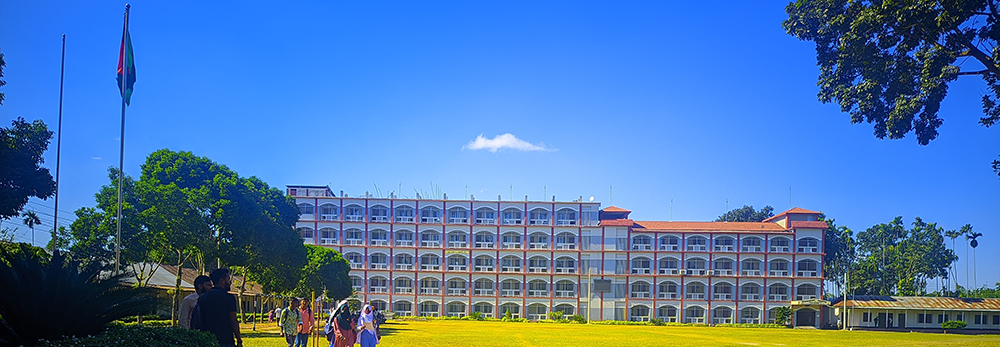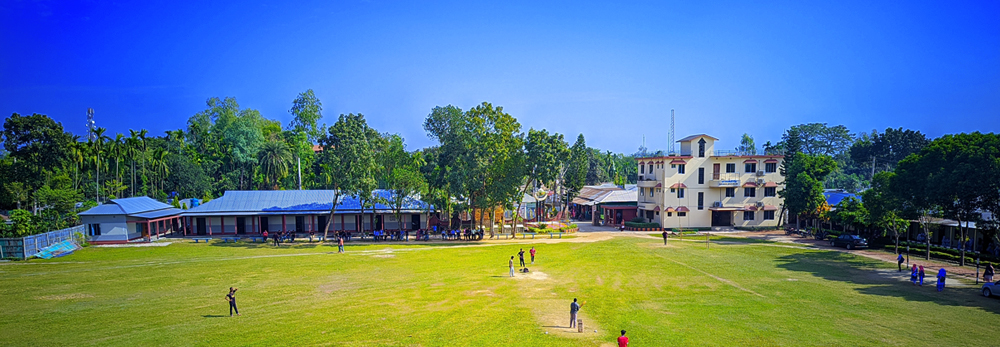About College
Welcome to Uttar Bangla College (UBC)!
There can be no gift of friendship truer than the sharing of knowledge. At Uttar Bangla College (UBC) in Kakina village of Lalmonirhat's Kaliganj upazila, Scotland's Sikh community has extended their hand of friendship across religions and continents through the donation of a campus library, named for the founder of Sikhism, Guru Nanak.
With a catalogue of 20,000 books in both Bangla and English covering history, science, literature and other fields of knowledge, the library has become an invaluable asset for the 6,000 students and around 200 faculty members of the college.
“Like other students, I sit in the Guru Nanak library everyday to read books and study,” says Bangla department student Mousumi Akter. “Because of the library we don't waste our leisure time. Instead we read books.”
Every day, from morning to evening, in excess of 500 students and teachers are drawn to the library, to read books, socialise and share ideas, with the library having also incorporated a teachers' union centre.
“Many students come from poor families,” says college Higher School Certificate student Helal Hossain. “Their families cannot buy books in the market, so they rely on the library. For us, it's a reading room, a source of knowledge and a place to share what we have read as well.”
The College itself, which offers up to honours level study in several disciplines, has been funded by Professor Dr Mozammel Huq, University of Strathclyde, Glasgow who originally hails from Kakina.
As the Founder of UBC, Dr Huq communicated with Glasgow's Sikh community to source donations for the library, which opened in 2003, initially with a single floor and literary assets of 5,000 books. Four years later a second floor was completed, with funding from Glasgow-based Charity Education International.
Vision, Mission & Strategy
The Oxford History of India categorically claims that there is no definitive information about Bengal before the third century BCE. It is believed that there were movements of Indo-Aryans, Dravidians and Mongoloids, including a people called Vanga, into Bengal.
The Bengal delta was made up of thick jungles and wetlands for several millennia. A major part of this geography lasted till historical times. The loss of the jungle was due to human activity. Bengal had an early human presence. But there is no consensus for the timeframe of the first human activity in Bengal nor are there plenty of remains. One view contends that humans entered Bengal from China 60,000 years ago. Another view claims that a distinct regional culture emerged 100,000 years ago. There is weak evidence for a prehistoric human presence in the region. There is scant evidence of a human presence during the Neolithic and Chalcolithic eras. This could be because of the shifts in the rivers' courses. The Bengali climate and geography is not suitable for tangible archaeological remains. Due to lack of stones the early humans in Bengal probably used materials such as wood and bamboo that could not survive in the environment. South Asian archaeologists have tended to focus on other parts of the subcontinent. Archaeologists interested in Bengal have focused on more recent history.
Archaeological discoveries are almost entirely from the hills around the Bengal delta. West Bengal and Bangladesh's eastern terrain offer the best source of information about the early peoples of Bengal. Industries of fossilwood manufacturing blades, scrapers and axes have been discovered in Lalmai, Sitakund and Chaklapunji. These have been connected with similar findings in Burma and West Bengal. Large stones, thought to be prehistoric, were constructed in north eastern Bangladesh and are similar to those in India's nearby hills. Farming was practised before the first millennium BCE. West Bengal holds the earliest evidence of settled agrarian societies.
Agricultural success gave ground in the fifth century BCE for a stationary culture and the emergence of towns, cross-sea trade and the earliest polities. Archaeologists have uncovered a port at Wari-Bateshwar which traded with Ancient Rome and Southeast Asia. The archaeologists have discovered coinage, pottery, iron artifacts, bricked road and a fort in Wari-Bateshwar. The findings suggest that the area was an important administrative hub, which had industries such as iron smelting and valuable stone beads. The site shows widespread use of clay. The clay, and bricks, were used to build walls. The most famous terracotta plaques, made by clay, are from Chandraketurgah and depicts deities and scenes of nature and ordinary life. The early coinage discovered in War-Bateshwar and Chandraketugarh depict boats.
Many of archaeological excavations in Bangladesh revealed evidences of the Northern Black Polished Ware (NBPW or NBP) culture of the Indian Subcontinent (c. 700–200 BC), which was an Iron Age culture developed beginning around 700 BC and peaked from c. 500–300 BC, coinciding with the emergence of 16 great states or mahajanapadas in Northern India, and the subsequent rise of the Mauryan Empire. The eastern part of ancient India, covering much of current days Bangladesh was part of one of such mahajanapadas, the ancient kingdom of Anga, which flourished in the 6th century BC.



